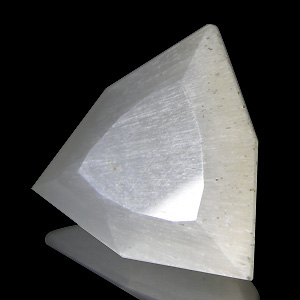Thomsonite

Thomsonite
(Shield cut, from USA. Chatoyant. 6.41 carat. 16.4 x 15.9 x 7.7mm)
Image © supplied by Freakingcat Gems
Thomsonite History & Etymology:
Thomsonite were first discovered in 1820 by the IMA and since then they are considered to be grandfathered crystals. Thomsonite were first analyzed by the famous Scottish mineralogist and chemist, Dr. Thomas Thomson. Thomsonite are hence named in his honor. Thomsonite subsequently were formally recognized by Zeolite Committee due t the varying inclusion of calcium in the composition.
Thomsonite Occurrence:
Thomsonite are extremely rare and gemstone quality crystals of Thomsonite are rarer. However the mineral Thomsonite can be found in many localities across the world while the crystals and gemstones of Thomsonite can be found only in few localities. Thomsonite are hence found only in the Lake Superior regions and in the Keweenaw Peninsula and Isle Royal in Michigan. Thomsonite are also found in the Grand Marais in Minnesota.
Thomsonite found in the Lake Superior area are usually of gemstone quality and have beautiful eye patterns on them usually in green. However faceting of Thomsonite is extremely difficult, even the crystals yielded from the regions of Lake Superior.
Thomsonite Properties:
Thomsonite have varying compositions which includes varying percentages of sodium, calcium, aluminum and silicon. The dominant presence of silicon classifies the Thomsonite mineral as silicates mineral. The composition of Thomsonite crystals also include impurities like copper and iron which give the tan coloring and the beautiful eye patterns on the crystals.
Thomsonite display orthorhombic and dipyramidal properties and the Thomsonite crystals occur as prismatic crystals in their natural form. The crystalline masses of the Thomsonite can also be elongated and at least 12 cm in size with massive striations on the faces. Twinning is commonly observed on most of the Thomsonite crystals.
Thomsonite have distinct and good cleavages along with conchoidal, uneven and sometimes sub-conchoidal fracturing. The presence of cleavages and fracturing makes Thomsonite extremely brittle thus also making faceting extremely difficult. The Moh’s hardness of the Thomsonite crystals is between 5 and 5.5. Thomsonite are not very dense and have an average density of approx. 2.35 g/cm3. Thomsonite does not display properties of luminescence nor is it radioactive.
Thomsonite occur in a variety of colors. The coloring of Thomsonite varies according to the percentages of common impurities in the composition like copper and iron. Hence Thomsonite occur in colorless form as well as in the colors of white, tan, green, pink and yellow. Thomsonite are characterized by concentric circles better known as the ‘eye’ patterns. The concentric circles are quite pronounced on the pink colored crystals of Thomsonite.
Thomsonite are rarely completely transparent and are usually translucent. They have a vitreous luster which changes to glassy or a pearly sheen on the edges. The beautifully patterned crystals of Thomsonite are quite sought after in the niche markets for rare gemstones.
Back to the Gemstones List home page - over 160 gemstones explored!
Please feel free to link to this page - copy / paste the text below: (click to select)
Privacy Policy | Cookie Policy | GDPR | About This Site / Terms

© gemstoneslist.com 2018


